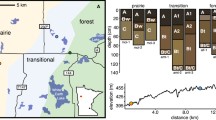Summary
Magnetic susceptibility, and its frequency dependence, are reported for 288 individual samples spanning the 8.3 m — thick S3 palaeosol/L4 loess couplet at an important site in the Chinese Loess Plateau. The resulting profile demonstrates that there is a very close link between magnetic properties and soil development: soil and loess sub-divisions recognised visually in the field are clearly reflected in both the bulk susceptibility data and in its frequency dependence. As found at all Chinese sites, the distribution of susceptibilities is bi-modal, one peak representing loess (median=0.74×10−6m3/kg), the other representing palaeosol (median=2.99×10−6m3/kg). This is the basis of the climatic proxy information. The Baoji section is the site of one of the most detailed grain-size analyses available anywhere (Ding et al., 1994), and we find a strong correlation between the resulting profile and the susceptibility data reported here. Frequency-dependence of susceptibility exhibits slight differences between the loess and palaeosol populations which we interpret as reflecting reduced transport distances during glacial intervals when the Siberian High causes stronger winds and expands southwards.
Similar content being viewed by others
References
An Z.S., Wang J. and Li H., 1977: Paleomagnetic research of the Lochuan loess section.Geochimica 4, 239–249.
Banerjee S.K., Hunt C.P. and Liu X.M., 1993; Separation of local signals from the regional paleomonsoon record of the Chinese loess plateau: A rock-magnetic approach.Geophys. Res. Lett. 20, 843–846.
Ding Z.L., Han J.T., Liu C. and Liu T.S., 1991: Preliminary determination of an abrupt climatic shift in North China at about 2·5 Ma.Chinese Science Bulletin 36, 852–856.
Ding Z.L., Yu Z., Rutter N.W. and Liu T.S., 1994: Toward an orbital time scale for Chinese loess deposits.Quat. Sci. Rev. 13, 39–70.
Evans M.E. and Heller F., 1994: Magnetic enhancement and palaeoclimate: Study of a loess/palaeosol couplet across the Loess Plateau of China.Geophys. J. Int. 117, 257–264.
Forster Th., Evans M.E. and Heller F., 1994: The frequency dependence of low field susceptibility in loess sediments.Geophys. J. Int. 118, 636–642.
Forster Th., Heller F., Evans M.E. and Havlíček P., 1996: Loess in the Czech Republic: Magnetic properties and Paleoclimate,Studia geoph. geod. 46, 243–261.
Heller F. and Evans M.E., 1995: Loess magnetism.Reviews of Geophysics 33, 211–240.
Heller F. and Liu T.S., 1982: Magnetostratigraphical dating of loess deposits in China.Nature 300, 431–433.
Heller F., Liu X.M., Liu T.S. and Xu T.C., 1991: Magnetic susceptibility of loess in China.Earth Planet. Sci. Lett. 103, 301–310.
Kletetschka G. and Banerjee S.K., 1994: Are natural fires the paleoclimatic variable recorded in the magnetic signal of Chinese loesss?New Trends in Geomagnetism IV (abstract), Třešt', September 1994, pp.19.
Kukla G., An Z.S., Melice J.L., Gavin J. and Xiao J.L., 1990: Magnetic susceptibility record of Chinese loess.Trans. R. Soc. Edinburgh Earth Sci. 81, 263–288.
Liu X.M., Rolph T.C. and Bloemendal J., 1995: The citrate-bicarbonate-dithionite (CBD) removable magnetic component of Chinese Loess.Quaternary Proceedings 4, 53–58.
Maher B.A., 1988: Magnetic properties of some synthetic sub-micron magnetities.Geophys, J. Int. 94, 83–96.
Maher B.A. and Thompson R., 1992: Paleoclimate significance of the mineral magnetic record of the Chinese loess and paleosols.Quat. Res. 37, 155–170.
Mullins C.E., 1977: Magnetic susceptibility of the soil and its significance in soil science — A review.J. Soil Sci. 28, 223–246.
Rutter N.W., Ding Z.L., Evans M.E. and Liu T.S., 1991: Baoji type pedostratigraphic section, loess plateau, north-central China.Quat. Sci. Rev. 10, 1–22.
Verosub K.L., Fine P., Singer M.J. and TenPas T., 1993: Pedogenesis and paleoclimate: Interpretation of the magnetic susceptibility record of Chinese loess-paleosol sequence.Geology 21, 1011–1014.
Wang Y., Evans M.E., Rutter N.W. and Ding Z., 1990: Magnetic susceptibility of Chinese loess and its bearing on paleoclimate.Geophys. Res. Lett. 17, 2449–2451.
Wang Y., Evans M.E., Xu T.C., Rutter N.W., Ding Z. and Liu X.M., 1992: Rescaled range analysis of paleoclimatic proxies.Can. J. Earth Sci. 29, 296–300.
Zhou L.P., Oldfield F., Wintle A.G., Robinson S.G. and Wang J.T., 1990: Partly pedogenic origin of magnetic variations in Chinese loess.Nature 346, 737–739.
Author information
Authors and Affiliations
Rights and permissions
About this article
Cite this article
Evans, M.E., Ding, Z. & Rutter, N.W. A high-resolution magnetic susceptibility study of a loess/palaeosol couplet at Baoji, China. Stud Geophys Geod 40, 225–233 (1996). https://doi.org/10.1007/BF02300739
Received:
Revised:
Issue Date:
DOI: https://doi.org/10.1007/BF02300739



